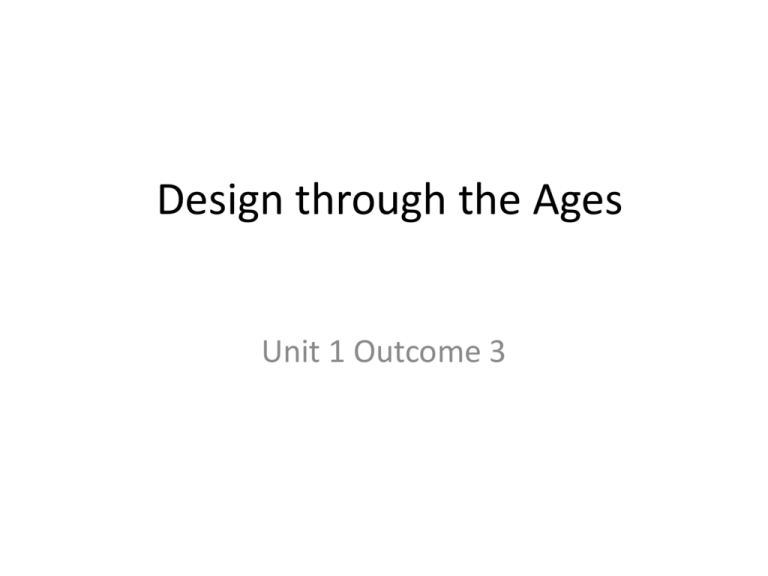File - Connect the Line
advertisement

Design through the Ages Unit 1 Outcome 3 • Our ancestors who drew on cave walls, often depicting hunting scenes. • The first known use of graphic symbols for communication was by the Sumerians in Mesopotamia (modern day Iraq), around 3500 BC. • early symbol - pictograph form, considered the origin of written language. The ancient Egyptians developed their own system of visual communication known as hieroglyphics - pictograph form. • Map making/cartography is as old as civilisation. Early forms of maps were scratched into rocks. The ancient Greek civilisation developed mathematical ways of mapping the earth. One significant attempt at arranging images for communication was the handwritten copy of the bible, called the Book of Kells, which was created by Irish monks in 800#AD. It is a good example of how images were used with written words to convey messages and bible stories. Printing technology was developed in the fourteenth century by Johannes Gutenberg. He invented the Gutenberg printing press, which allowed individual letters and decorative images to be re-used. The Gutenberg press produced the first printed book. In the nineteenth century, the graphic design evolution was boosted through book publishing and the distinction between fine art and visual communication design evolved. The twentieth century produced many design styles and eras that still influence modern design today. Many of today’s designers use characteristics and features from past eras in their work. Understanding design history can help develop skills in analysing visual communications, provide a research starting point for a design brief, influence the way we use elements and principles in our own work and assist in creating our own design style, which may be influenced by a favourite design era or designer within that era. Key Design Eras Arts and Crafts 1850–1914 - a movement based on simple forms, patterns and textures. Designers focused on domestic items and used simple plant forms and organic shapes in their designs. - - - - It was heavily influenced by the writing of John Ruskin as a reaction to the mechanical style of the industrial revolution and also to the intricate and elaborate style of the Victorian era. decoration was based on plant forms, natural rhythm of organic shapes and flowers. Leaf motifs and heart shapes Some Australian designers including furniture makers embraced this style and used Australian timbers in their designs. Key designers from this era include: William Morris Charles Rennie Mackintosh Frank Lloyd Wright Aesthetic Movement – “purely beautiful” The Aesthetic movement was heavily inspired by Japanese culture and the art form of Japanese woodcuts. The movement was focused on the natural, and the beautiful mixing of Anglo and Japanese style. Key designers from this era include: - Aubrey Beardsley - James Abbott McNeil Whistler Art Nouveau c. 1890 – 1910 - The beginning of the twentieth century was a time of ‘new art for a new century’. - a style of decoration and architecture characterised by the flowing depiction of leaves and flowers. It started in Paris in the 1890s and continued through to World War I. Art Nouveau was inspired by natural forms and structures, not only in flowers and plants, but also in curved lines. - The flowery, ornate style developed overnight in 1894 by Alphonse Mucha who produced a poster for the actress Sarah Bernhardt. - the original masterpiece of Art Nouveau poster design: with its decoration, swirls and ornate design, it was a reaction against Modernist ideals. - The poster art craze spread to America and around Europe, and although local in style the distinct characteristics of the era remained. Decorative motifs, formed by dynamic flowing lines, were the characteristics of this period. Art Nouveau was applied to architectural forms, painting, poster art, sculpture and other design forms. Key designers from this era include: - Charles Rennie Mackintosh - Victor Horta - Alphonse Mucha - Hector Guimard - Aubrey Beardsley - Bram Van der Velde Modernism: Modernism is a design aesthetic that developed in the early part of the 20th century. It reflected the “Zeitgeist” or ‘spirit of its age’. Rising from the bleakness of wars modernism was optimistically underpinned by the utopian social ideals. Modernists rejected decorative motifs in favour of clean, functional forms. Surface decoration was minimally used. Modernism was characterised by the use of modern materials such as steel and glass, the application of abstract forms, the manipulation of space and a conservative colour palette. Dominated by whites, greys and black. “Less is More” Futurism 1909 - 1930 - an artistic and social movement originated in Italy in the early twentieth century. - It emphasised contemporary concepts of the future, including speed, technological progress and youth, and objects such as the car, the aeroplane and the industrial city. - Inspired by Cubism - Used repetitive lines and angles in images meant to capture a dimension of time within a frame - Brilliant colour - Explored bold, complex, - Fragmented typography, shapes and icons. Not unusual to use 20 typefaces on a page and up to 4 colours – demonstrated expressive power Key Designers: Giacomo Bella Carlo Carra Umberto Boccioni Dada 1916 - 23 Dada, or Dadaism, is a cultural movement that began in Zurich, Switzerland, during World War 1. The movement involved visual arts, literature, poetry, art manifestos, art theory, theatre and graphic design. Dada was intended to provoke an emotional reaction from the viewer (typically, shock or outrage). The Dadaists influenced graphic design by creating imagery that was unconventional in composition and included chance results or accident as a means of production and technique. Dada artists produced works that had a cynical attitude toward social values and were, at the same time, irrational — absurd and playful, emotive and intuitive, and often cryptic. De Stijl 1917 -1931 De Stijl, which is Dutch for ‘The Style’, was a Dutch artistic movement founded in 1917. - De Stijl sought to express a new ideal of harmony and order. - abstraction and minimised design to the essentials of form and colour; - simplified visual compositions by using vertical and horizontal directions, and used only primary colours along with black and white. - Decoration and ornamental design was rejected and the designers of this period focused on simplification of forms. The fundamental principle of the geometry of the straight line, the square and the rectangle was combined with strong asymmetrical composition Piet Mondrian Key designers: Theo van Doesburg, Gerrit Rietveld, Bart Van der Leck, Mondrian Art Deco 1920 -1939 -an eclectic artistic and design style that began in Paris in the 1920s and flourished Internationally throughout the 1930s, into the World War II era. It is characterised by streamlined geometric shapes. Art Deco represented the style of the Machine Age, replacing Art Nouveau’s flowing floral motifs with streamlined geometric shapes and designs that represented power, speed and modern technology. Art Deco took its inspiration from a variety of art movements, including Cubism and Futurism. Simplification and abstraction were the hallmarks of Art Deco; its style was used in architecture, interior design, industrial design, fashion design and graphic arts. Themes to represent the emerging Machine Age included modern aviation, electrical lighting, the radio, the ocean liner, the car and the skyscraper. Art Deco is characterised by the use of materials such as aluminium, stainless steel, inlaid wood and lacquer. The use of bold stepped forms and the sunburst motif are typical Art Deco features. Geometric curves including zig zag design and fountain shapes were evident. Some of these motifs are so famous that they are significantly distinctive in skylines around the world. Geometric shapes and line as dominant design elements. The exaggeration of scale in both posters was a design principle employed to demonstrate the technology available at the time. Lightning flashes and bold line work were also employed in these posters to create a sense of power, glitz, glamour and wealth (The Great Gatsby).Opulent, lavish style, a reaction to the hardships of WW2 Key Designers: Cassandre, Van Alen, Jean Carlu, Legrain, Fortuny, Proctor, Burley Griffin, Jardine Bauhaus 1919 – 1933 The Bauhaus movement was one of the most important design movements of the twentieth century in Germany in the 1920s and early 1930s. Bauhaus means ‘Building School’, and it was the name of a German institution that combined crafts and fine arts, and was famous for publicising and teaching its approach to design. The style of the school was characterised by functional designs with no ornamentation. It pointed out the benefits of using basic materials with no decorations. Some of the most important artists and architects of the school were Paul Klee, Wassily Kandinsky and László Moholy-Nagy, who founded the Graphic Institute of Chicago and taught using the Bauhaus teaching methods. The principles of Bauhaus design: - to provide everything in the contemporary house, from the most basic household item to the complete building. - designers fascinated with metal, used it in furniture design to create a new type of beauty that relied on non-exact forms and measurements. Steel was a material that was uniform and precise. One key aims of the Bauhaus movement was to unify art, craft and technology. The machine was considered to be a positive influence on architectural design, furniture design, product design and industrial design. Key elements of Bauhaus - ALL caps or All lower case - Sans serif - Grid structure and geometric form - Bold and primary colours







